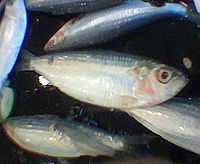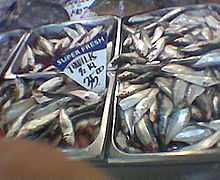Sardinella tawilis
| Freshwater sardinella | |
|---|---|
 | |
| Sardinella tawilis being sold in a market. | |
| Conservation status | |
| Scientific classification | |
| Kingdom: | Animalia |
| Phylum: | Chordata |
| Class: | Actinopterygii |
| Order: | Clupeiformes |
| Family: | Clupeidae |
| Genus: | Sardinella |
| Species: | S. tawilis |
| Binomial name | |
| Sardinella tawilis (Herre, 1927) | |
| Synonyms | |
|
Harengula tawilis Herre, 1927 | |
Sardinella tawilis (the freshwater sardinella, freshwater herring, or bombon sardine), is a freshwater sardine found exclusively in the Philippines. It is the only member of the genus Sardinella known to exist entirely in fresh water.[1] Locally, they are known in Filipino as tawilis.[2]
Description
S. tawilis is a small fish reaching up to 15 cm and weighing less than 30 g. Like other members of their family, they have laterally compressed bodies with bellies covered in tough, scale-like scutes. They have a single, triangular dorsal fin and a forked caudal fin. They possess long, slender gill rakers in their mouths.[2]
Range and distribution
S. tawilis populations are found only in a Taal Lake in Batangas and Zamboanga City province on the island of Luzon and Mindanao in the Philippines. The third-largest lake in the Philippines used to be the caldera of an ancient volcano.[3] Before recent history, the lake was but an extension of the entirely marine Balayan Bay. Major eruptions in the 18th century essentially sealed the lake from the sea, eventually leading its waters to become fresh water. S. tawilis is believed to be one of a few former marine species trapped within the lake that have evolved into purely freshwater species.[2]
Ecology
S. tawilis, like members of its family, is an epipelagic filter feeder, using its gill rakers to strain plankton from the water while it swims with its mouth open. They roam the lake in large schools, just below the surface as the volcanic (and thus sedimentary) nature of the lake limits their plankton food to the surface.
The freshwater sardinella prefers to ingest larger prey, such as adult copepods, supplemented with rotifers and water fleas. During the summer months when the density of smaller copepods were much higher, their stomach contents consisted primarily of calanoid copepods, which are larger than the copepods blooming during this time. This suggests some partial control over prey selection exhibited by the fish, as opposed to simple filter-feeding.[4]
Little is known about their reproduction.[5] It is known that the Taal population spawns during the months of April to July, when surface temperatures are highest.[4]
Etymology and taxonomic history
Sardinella is the diminutive of the Greek sarda, meaning literally "little sardine".
The species was originally identified and named in 1927 as Harengula tawilis by Albert William Herre, the Chief of the Fisheries Division of the Bureau of Science in Manila. The species was later moved to the more appropriate and taxonomically accurate genus, Sardinella.[2]
Importance to humans

Despite its threatened status,[6] stocks in Lake Taal have been commercially fished for several decades. The fish is a widely popular food fish in the Philippines, and tons are shipped to most of the major cities in the country. Local supermarkets and wet markets usually have a tray or pile dedicated solely to the species.
The species is commonly referred to as tawilis in the local language of Tagalog. On the island of Cebu, one of the many places where tawilis is shipped, the native Cebuano name for the fish is tunsoy.[2]
In addition to raw consumption, tawilis is also processed into various food products. It is one of the many fish species dried, salted, and sold as daing in the country. They are also smoked and bottled in oil, and sold commercially.
In literature, Jose Rizal used three dried tawilis in his novel Noli Me Tangere to symbolize the Three Martyred Priests of Bagumbayan (Jose Burgos, Jacinto Zamora and Mariano Gómez).
Conservation
Because of several factors, the species is threatened by overfishing. As with all species consisting of a single population in one location, a local extinction event will lead to species extinction. As the population of the Philippines grows, the demand will be greater for tawilis, possibly overfishing the lake's stock population.
References
- ↑ Froese, Rainer, and Daniel Pauly, eds. (2010). Sardinella tawilis in FishBase. November 2010 version.
- ↑ 2.0 2.1 2.2 2.3 2.4 Froese, Rainer, and Daniel Pauly, eds. (2010). Sardinella tawilis in FishBase. November 2010 version.
- ↑ "A Decade Volcano". A Homepage for Taal Volcano. Retrieved on 2011-02-10.
- ↑ 4.0 4.1 Papa, Rey Donne S.; Roberto C. Pagulayan and Alicia Ely J. Pagulayan (2008). "Zooplanktivory in the Endemic Freshwater Sardine, Sardinella tawilis (Herre 1927) of Taal Lake, the Philippines". Zoological Studies (Taipei, Taiwan: Academia Sinica) 47 (5): 535–543. Retrieved 2008-12-26.
- ↑ Castillo, B.B.; A.S. Castillo and C.L. Gonzales (1975). "Tawilis fishery resources investigation of Taal Lake.". Philippine Council for Agriculture and Resources Research Fisheries Forum. Los Baños, Laguna, Philippines: Philippine Council for Agriculture and Resources Research. pp. 75–98.
- ↑ (2010_11). "Sardinella Tawilis, Philippine Information". FishBase. Retrieved on 2011-02-10.
- "Sardinella tawilis". Integrated Taxonomic Information System. Retrieved 7 January 2007.
- Whitehead, Peter J.P. (1985). "FAO species catalogue. Vol. 7. Clupeoid fishes of the world (suborder Clupeioidei). An annotated and illustrated catalogue of the herrings, sardines, pilchards, sprats, shads, anchovies and wolf-herrings. Part 1 - Chirocentridae, Clupeidae and Pristigasteridae". FAO Fisheries Synopsis (Rome, Italy: Food and Agriculture Organization of the United Nations) 125 (7/1): 1–303. ISBN 92-5-102340-9.
References
External links
- "Born to be Wild: Tawilis" on GMA News Online (2008_0313)
